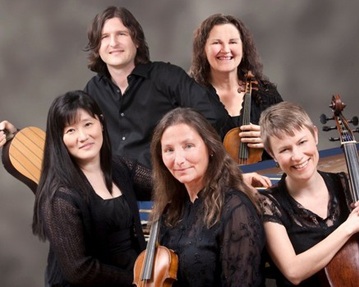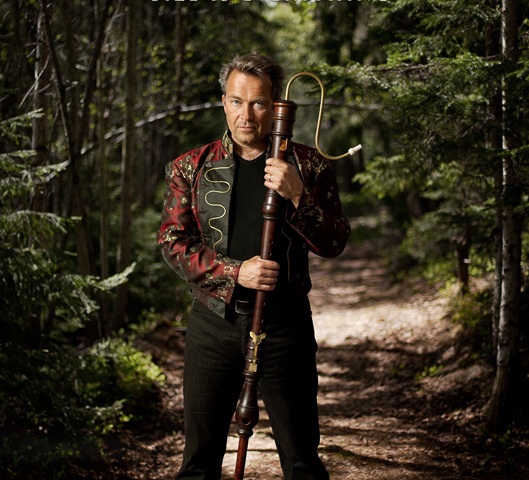 The end of our 2014–15 concert season comes too soon, a reminder, perhaps, of how brief our dry, Mediterranean spring has been. SFEMS’s finale, however, will be a sprightly, joyful celebration of and for the season. The weekend of April 10–12, we welcome back the Bay Area’s Ensemble Mirable (JungHae Kim, harpsichord; Elizabeth Blumenstock and Katherine Kyme, violins; Joanna Blendulf, viola da gamba; and Kevin Cooper, baroque guitar) and celebrate the return of Swedish recorder virtuoso Dan Laurin, whom we presented some two decades ago with his own ensemble, Parnassus Avenue.
The end of our 2014–15 concert season comes too soon, a reminder, perhaps, of how brief our dry, Mediterranean spring has been. SFEMS’s finale, however, will be a sprightly, joyful celebration of and for the season. The weekend of April 10–12, we welcome back the Bay Area’s Ensemble Mirable (JungHae Kim, harpsichord; Elizabeth Blumenstock and Katherine Kyme, violins; Joanna Blendulf, viola da gamba; and Kevin Cooper, baroque guitar) and celebrate the return of Swedish recorder virtuoso Dan Laurin, whom we presented some two decades ago with his own ensemble, Parnassus Avenue.
Mirable’s concert takes its name from Vivaldi’s beloved “Spring” concerto from The Four Seasons, with its evocation of birdsong, thunderstorms, a sheepdog and bagpipes. Violinist Elizabeth Blumenstock has created a special arrangement of Vivaldi’s masterpiece for these performances.
Three of the works for recorder on Mirable’s program are found in the Manoscritto di Napoli (1725), a collection of 24 compositions for recorder, strings and basso continuo by various composers. The collection purportedly was commissioned by the Austrian Viceroy of Naples (and recorder player) Count Aloys Thomas Raimund von Harrach, whose presence in Naples (1728–1733) may have been responsible for the abundance of works for the recorder in Naples around that time.
The Sonata Terza by violinist and composer Francesco Barbella (1692–1733) and the Sonata Ottava by Francesco Mancini (1672–1737) exemplify the stylistic diversity in Naples at the beginning of the 18th century: Mancini favors asymmetrical phrase lengths and imitation of thematic material, often contrasted with purely theatrical tone painting or folkloristic movements. Barbella writes in a more modern style. In the Sonata Ottava, he uses the change between major and minor modes to express ambiguity and uncertainty—but like all of his contemporaries, Barbella uses a fugato to stabilize the emotions with reason.
 Seven of the 24 works in the collection were penned by Alessandro Scarlatti (1660–1725). Perhaps best known as a prolific opera composer, Scarlatti was the Musical Director of the Neapolitan Court on and off from 1684 to his death in 1725 (Mancini was his Assistant Director from 1708–1725). The Sonata Nona in A Minor was written toward the end of Scarlatti’s lifetime and is among the seven he authored in the Naples Manuscript.
Seven of the 24 works in the collection were penned by Alessandro Scarlatti (1660–1725). Perhaps best known as a prolific opera composer, Scarlatti was the Musical Director of the Neapolitan Court on and off from 1684 to his death in 1725 (Mancini was his Assistant Director from 1708–1725). The Sonata Nona in A Minor was written toward the end of Scarlatti’s lifetime and is among the seven he authored in the Naples Manuscript.
Other concert highlights include sonatas by Giovanni Gabrieli and Arcangelo Corelli, a toccata of Girolamo Frescobaldi, and a gorgeous ciaccona by Maurizio Cazzati.
The earliest work on the program, Sonata XXI con tre violini by the great Venetian composer and organist Giovanni Gabrieli (ca. 1553–1612), was first published after the composer’s death, in 1615. The lovely and gentle interplay between lines offers a more intimate view of Gabrieli, who is now more widely known for his large-scale, antiphonal canzonas and choral works. The same year saw the publication of Girolamo Alessandro Frescobaldi’s (1583–1643) Toccate e partite d’intavolatura, Libro I, a seminal work in the development of music for harpsichord and among his most important compositions. Frescobaldi revised and expanded the collection in 1616 and again in 1637. In the Forward, he provides fairly extensive instructions to the performer regarding tempo, interpretation and ornamentation. His toccatas are rhythmically quite varied, intense, and reflect a dazzling virtuosity.
Francesco Turini (ca. 1595–1656), was an Italian organist and composer, born in Prague around 1595 to a musical family; his father was a singer and cornetto player in the court of Emperor Rudolf II. Francesco studied with his father and became court organist at the age of 12. He was later sent by Rudolf II to Italy to study in Venice and Roma before returning to Prague, where he resumed his position as organist. When Rudolf II died in 1612, he returned to Italy and worked in Venice for a time. By 1620 he began working as organist in the cathedral at Brescia, where he remained until his death 36 years later. He is known for both vocal and instrumental music.
The lovely and buoyant Trio Sonata in C Major by Arcangelo Corelli (1653–1713) was published in 1681 as part of a set of 12 trio sonatas and dedicated to Christina, former Queen of Sweden and patron of the arts. Christina had been Scarlatti’s patron earlier in his career, when he was appointed her maestro di cappella prior to his leaving for Naples in 1683. Corelli, in a note to Christina, asked that she protect the “first fruits of (his) study,” perhaps concerned that they would not be well-received. The work on this program is the only trio sonata in this opus comprised of three movements; the remainder being comprised of 4 or 5 movements.
 Mirable’s spring celebration concludes with Maurizio Cazzati’s (1616–1678) gorgeous ciaccona. Published in 1660, Cazzati’s work reflects an improvisational spirit, with a ground bass providing the foundation over which virtuosic flourishes are passed amongst musicians in lively interplay before drawing, all too soon, to a close.
Mirable’s spring celebration concludes with Maurizio Cazzati’s (1616–1678) gorgeous ciaccona. Published in 1660, Cazzati’s work reflects an improvisational spirit, with a ground bass providing the foundation over which virtuosic flourishes are passed amongst musicians in lively interplay before drawing, all too soon, to a close.
Guest artist, Dan Laurin, is one of the world’s greatest recorder players. The recipient of many awards, including a Grammy and the Interpreter’s Prize from the Royal Swedish Academy of Music, he has made more than 30 recordings, with a repertory ranging from early Renaissance to 21st-century music. His efforts to broaden the recorder’s literature have resulted in new concertos for the instrument with large orchestra that already are considered classics.
Among his recordings, special mention should be made of his 9-CD set of the complete Der Fluyten Lust-hof, Jacob van Eyck’s monumental, mid 17th-century collection, which remains the largest work in European history ever written for a wind instrument. Laurin’s much-praised recording was itself a landmark and a unique accomplishment. Laurin also had a long and fruitful collaboration with the late, legendary Australian instrument maker Frederick Morgan, to replicate historical recorders of various craftsmen from different eras. Among these was a special instrument designed to perform Der Fluyten Lust-hof.
Ensemble Mirable (Mirable – Old French, meaning astonishing, strong, powerful) originated in 1996 at Indiana University’s Early Music Institute while Joanna Blendulf and JungHae Kim were working toward graduate degrees. Since its inception, the group’s focus has been on exploring the many variations in continuo performance across different baroque styles. Ensemble Mirable is a flexible performing entity, maintaining the ability to change and grow to meet the needs of different scale continuo demands. The members feel that in order to provide an exciting and yet elegant rendition of this repertoire, it is necessary to work within the composer’s stylistic framework. Their last performance for San Francisco Early Music Society on the 2008–2009 concert series was enthusiastically received, and a recording of the works from that concert (Influenza Italiana) is now available on compact disc.
SFEMS presents Ensemble Mirable with Dan Laurin, recorder, on Friday, April 10, 8:00 p.m., at First Lutheran Church of Palo Alto; Saturday, April 11, 7:30 p.m., at St. John’s Presbyterian Church in Berkeley; and Sunday, April 12, 4:00 p.m. at St. Mark’s Lutheran Church in San Francisco. Order tickets online or call the SFEMS box office at 510-528-1725.












